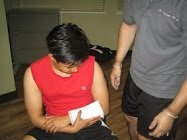Overview
Knocks, bumps and bruises are frequent injuries that everybody will come into contact with at some point in their lives. Though they can occasionally be very sore, knocks, bumps and bruises are generally easy to treat. These types of injuries usually affect joints such as your knee and elbow, and bumps and knocks to these areas can lead to inflammation and bruising.

A bruise usually appears after you have been bashed, bumped or pinched, for instance when you fall when playing a contact sport, or bumped your body against something hard.
A bruise occurs when the small blood vessels underneath your skin are injured. The blood has no place to go, so a purple or red spot will appear on the skin.
Everybody bruises in different ways, for instance, kids are more prone to get knocks and bruises because they are usually more energetic. Older people generally have weak blood vessels which means they are more predisposed to bruising.
Some individuals bruise very quickly whereas others don’t.
Suspecting Deliberate Injury
If there is any doubt that these symptoms were caused intentionally, and were not the cause of an accident, you should get assistance from a healthcare expert. Consider speaking to your GP, nurse, or emergency clinic.
If you have a bump, knock or bruise there are several things you can do to help treat the condition. Following are some self-help guidelines:
- For a knock, bump or bruise, place a cold ice pack on the area immediately.
- An ice pack might alleviate inflammation but should not be positioned directly on the skin as this can damage the skin and prolong healing.
- If the area is painful, get guidance on medications you can take.
- Visit your local drugstore for guidance on extra products you can use to alleviate the symptoms.
Call a professional healthcare provider if:
- Your symptoms become even worse.
- New symptoms start to appear.
- As soon as you have injured yourself end further bleeding and inflammation (bruising) by using a method known as R. I.C.E.
| R | Rest the wounded area. |
| I | Ice on the bruised area. Conceal the ice in a rag rather than placing it directly onto your skin. (Cold peas in a plastic bag can also be used on the bruised area). |
| C | Compression dressing. Cover a bandage tightly around the bruised area, but not too tight. |
| E | Elevate the wounded part. You might need to make a sling to sustain the bruised part or find a pillow to rest it on. |
Related Video On Bruises and Bumps
https://www.youtube.com/watch?v=mzv9U4Pqs8U